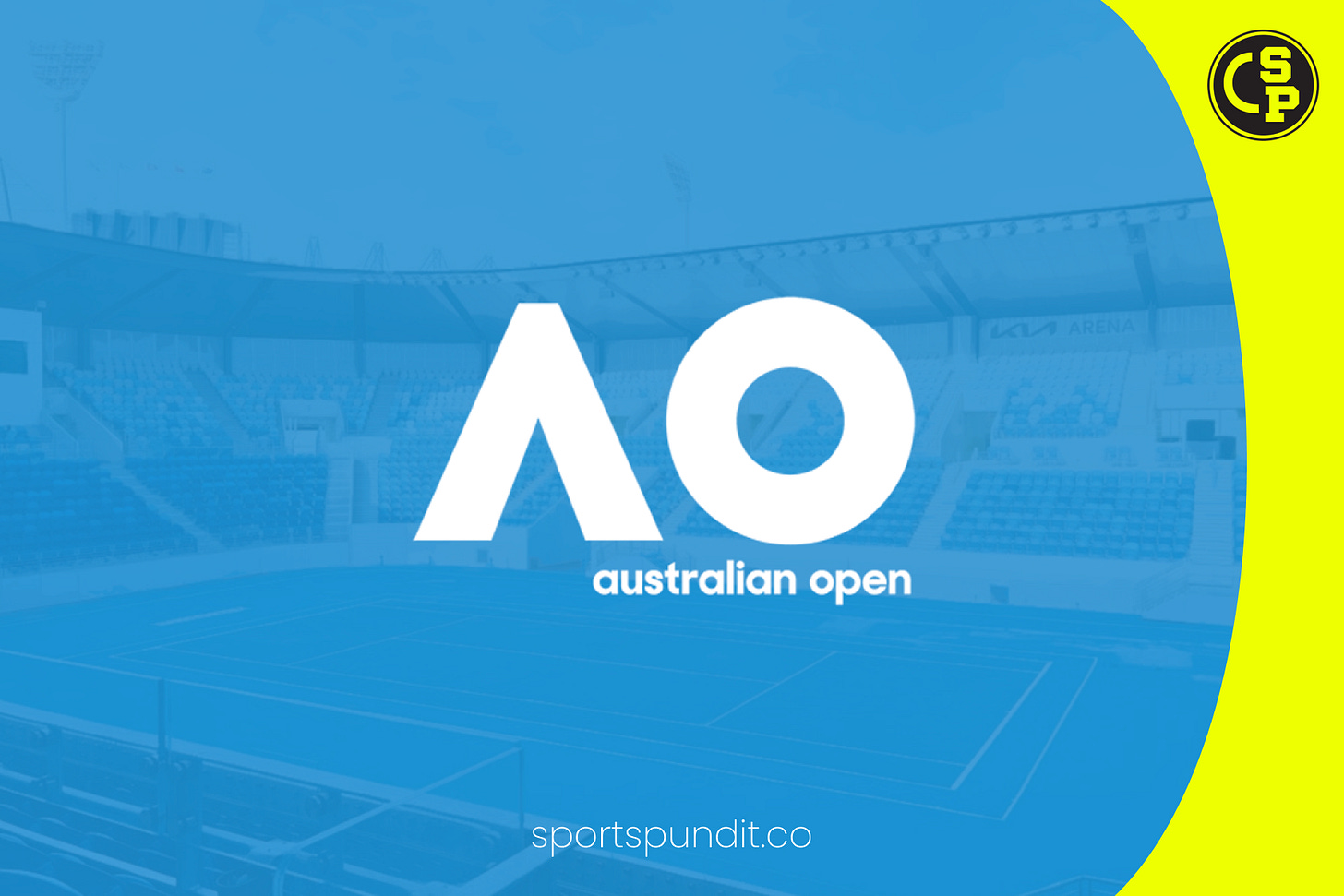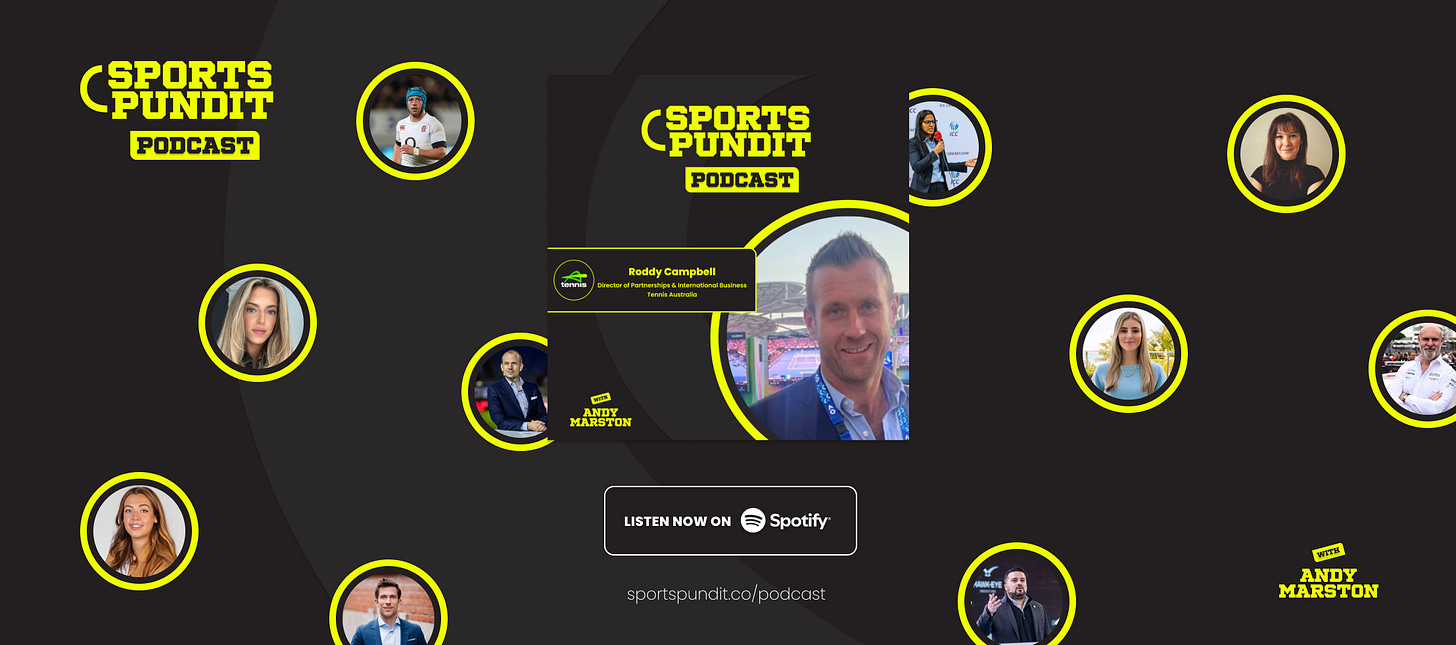Grand Slam: How the Australian Open Became Tennis’ Disneyland 🎾
The tennis will always be the main event. But standing out from the other Slams takes something more—a relentless focus on every detail that surrounds it...
Not yet a subscriber? Join over 3,000 sports business leaders, from Formula 1 to the Premier League, that read Sports Pundit every week to get impactful industry insights.
BIG IDEA
The Australian Open has spent the last decade reshaping what a Grand Slam can be.
It’s a tennis tournament, but it’s also a festival, a social event, and a proving ground for brands looking to make an impact.
Walk through Melbourne Park in January, and you’ll see as many people watching live music, exploring food pop-ups, or testing out a new brand activation as you will sitting in the stands. It’s a shift that has turned the AO into more than just a sporting event—it’s an experience that draws in audiences far beyond tennis purists.
As he explained on the Sports Pundit Podcast, Roddy Campbell, Director of Partnerships & International Business at Tennis Australia, sees that as a feature, not a distraction.
"It felt like an extraordinary opportunity because you're not just working in sports, you're working in culture, and that is just increasing every year," he said.
"Over time we’ve become known for that diversity. People come to the AO even if you don't like tennis, you can have a great time."
"That is now paying off with our reputation and the word-of-mouth effect, and people are coming from all over the world just to soak it up and experience it. We want it to be that bucket-list event. If you're going to go to one international sporting event, we'd love it to be the Australian Open."
This transformation is the result of a deliberate pillar strategy—one that has positioned the event as a cultural landmark rather than just another stop on the tennis calendar.
"Craig [Tiley] and the team set out to really segment and diversify the event, so they invested in programming around food, technology, retail, music, and gaming. There was a very deliberate journey to invest a lot in those early years without necessarily seeing the return," Campbell continued.
A big part of making that strategy work has been how the AO structures the event. Rather than forcing experiences onto attendees, it has leaned into segmentation, stretching the crowd across different areas of the park.
This has not only helped attract a more diverse audience but also brands with vastly different identities and goals.
"It's kind of like Disneyland, the way you've got certain zones that all have a different purpose and all target a different consumer."
Grand Slam Oval is packed with beverage activations, the Ballpark caters to families, and for 2025, AO introduced Topcourt, a brand-new space designed for younger fans with immersive gaming, music, fashion, and beauty experiences.
The brands that come on board aren’t just filling space; they help shape the identity of each area.
Red Bull and Mecca played a key role in defining Topcourt, giving it an energy that feels more like a youth culture festival than a traditional tennis activation. Red Bull’s Rally Padel Arena introduced fans to one of the fastest-growing sports in the world, while the Mecca Summer Club offered on-the-go beauty experiences, walk-in appointments, and courtside shopping. The combination ensured Topcourt delivered an experience that extended beyond sport and tapped into broader lifestyle trends.
Meanwhile, M&M’s took centre stage in Ballpark, turning its activation into an interactive space for families and younger children.
As Campbell explains, these aren’t passive sponsorships—each partnership is a co-creation, designed to enhance its surroundings rather than just occupy space.
Beyond physical activations, brand partners also brought their own cultural pull.
Ralph Lauren’s involvement saw K-Pop stars like Mark Lee attend, while Luzhou Laojiao brought Jackie Chan—illustrating the two-way exchange that the AO and Campbell have developed with their partners.
As the event experience has evolved, so too has its ability to welcome more attendees.
"That segmentation and stretching of crowds, along with stretching in terms of number of days by programming opening week with qualifiers and exhibition matches, and bringing the main draw forward to Sunday two years ago, that's enabled us to jump from 700,000 five years ago to 1.2 million, and I know there's ambition to go even higher."
The focus on continuous improvement shows no signs of slowing down with Campbell and the team, even during the tournament, walking around and starting to plot out what will change next year.
"The AO has a culture of innovation. Every year, Craig talks about doing 50% of things differently," says Campbell.
Campbell is also turning his attention to the programming that sits beyond Melbourne Park, with a keen ambition on expanding its impact even further throughout the city.
"We want to be the Super Bowl of APAC—an event where brands launch major campaigns and activate in creative ways."
At the Super Bowl, it’s reported that more than 800 conferences and activations take place in the lead-up to and around the game.
Campbell sees an opportunity to further mirror that model, encouraging more brands to treat the AO as a launchpad for major campaigns.
The infrastructure is already there, and the interest is growing. They’ve already made a start, too—with events like Emirates’ Business of Sport event, presented by Robb Report to name just one example among many.
The Australian Open has proven that a tennis tournament can be more than just what happens on the court. The sport remains at the heart of the event, of course, but its future success will be shaped just as much by what surrounds it.
SP PODCAST
Roddy Campbell [#45]: Transforming the Australian Open into the 'Super Bowl of APAC' 🎾
On today’s episode, I’m grateful to be joined by Roddy Campbell, Director of Partnerships & International Business at Tennis Australia
We’re catching up right off-the-back of the busiest three weeks of the year for Roddy and his team, having just seen the Australian Open conclude in Melbourne. The tournament has developed an incredible reputation as the 'startup slam’ and innovation flows through everything that they do - including across partnerships.
Although starting out in sport at The FA, Roddy has spent a lot of his career in the worlds of music and entertainment at the likes of EMI and Universal.
In our conversation, we discuss the “festivalisation" of sport, his team's co-creation approach to partnerships, their focus on China, and wanting to become the ’Super Bowl of APAC’, as well as much much more.
Not yet a subscriber? Join over 3,000 sports business leaders, from Formula 1 to the Premier League, that read Sports Pundit every week to get impactful industry insights.











